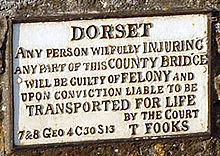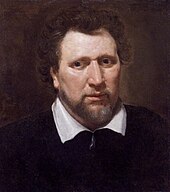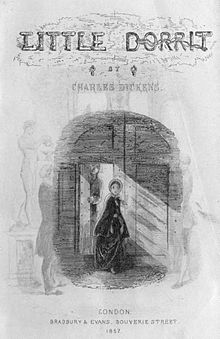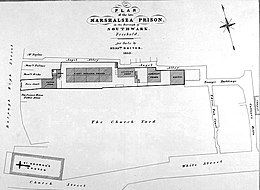Marshalsea
[3] Debtors in the 18th century who could afford the prison fees had access to a bar, shop and restaurant, and retained the crucial privilege of being allowed out during the day, which gave them a chance to earn money for their creditors.Forced as a result to leave school to work in a factory, Dickens based several of his characters on his experience, most notably Amy Dorrit, whose father is in the Marshalsea for debts so complex no one can fathom how to get him out.All that is left of the Marshalsea is the long brick wall that marked its southern boundary, the existence of what Dickens called "the crowding ghosts of many miserable years" recalled only by a plaque from the local council.From 1530 to 1698 the verge was usually 12 miles around the Palace of Whitehall, the royal family's main residence, but the Marshalsea was an ambulatory court that moved around the country with the king, dealing with trespass, contempt and debt.[12] Until the 19th century imprisonment in England was not viewed as a punishment, except for minor offences such as vagrancy; prisons simply held people until their creditors had been paid or their fate decided by judges.[19] My reader will judge of its malignity [the smell inside prisons] when I assure him that my cloaths were in my first journeys so offensive that in a post chaise I could not bear the windows drawn up: and was therefore often obliged to travel on horseback.One man found not guilty at trial in 1669 was not released because he owed prison fees from his pre-trial confinement, a position supported by the judge, Matthew Hale.If the prison did supply food to its non-paying inmates, it was purchased with charitable donations—donations sometimes siphoned off by the jailers—usually bread and water with a small amount of meat, or something confiscated as unfit for human consumption.[24] In a jail owned by the Bishop of Ely, Howard wrote, prisoners had ten years earlier been kept chained to the floor on their backs, with spiked collars round their necks and iron bars over their legs.Historian Jerry White writes that it existed by 1300, but according to Ida Darlington, editor of the 1955 Survey of London, there is a mention of "the good men of the town of Suthwerk" being granted a licence in 1373 to build a house on Southwark's High Street to hold prisoners appearing before the Marshalsea of the King's household.He paid Darby £140 a year (equivalent to £26,000 in 2023) for a seven-year lease, giving him the right to act as resident warden and chief turnkey, and an additional £260 for the right to collect rent from the rooms, and sell food and drink.John Baptist Grano (1692 – c. 1748), one of George Frederick Handel's trumpeters at the opera house in London's Haymarket, was jailed there for a debt of £99 (£17,000 today), and kept a detailed diary, A Journal of My Life inside the Marshalsea, of his 458-day incarceration from 30 May 1728 until 23 September 1729.[52] What often finished them off was being forced to lie in the strong room, a windowless shed near the main sewer, next to piles of night soil and cadavers awaiting burial.[53] One apparently diabetic army officer who died in the strong room—he had been ejected from the common side because inmates had complained about the smell of his urine—had his face eaten by rats within hours of his death, according to a witness.[55] Ginger writes that Acton and his wife, who lived in a comfortable apartment near the lodge, knew they were sitting on a powder keg: "When each morning the smell of freshly baked bread filled ... the yard ... only brutal suppression could prevent the Common Side from erupting.Unable to pay the prison fee, he had been burned with a red-hot poker, hit with a stick and kept in a dungeon for ten days for having wounded the warden with a shoemaker's knife.All the Support such poor Wretches have to subsist on, is an accidental Allowance of Pease, given once a week by a Gentleman, who conceals his Name, and about Thirty Pounds of Beef, provided by the voluntary Contribution of the Judge and Officers of the Marshalsea, on Monday, Wednesday, and Friday; which is divided into very small Portions, of about an Ounce and a half, distributed with One-Fourth-part of an Half-penny Loaf ...[63]As a result of the Gaols Committee's inquiries, several key figures within the jails were tried for murder in August 1729, including Thomas Bambridge of the Fleet and William Acton of the Marshalsea.Wanting to know who had supplied the rope, Acton beat him with a bull's pizzle, stamped on his stomach, placed him in the hole (a damp space under the stairs), then in the strong room.Captain John Bromfield, Robert Newton and James Thompson all died after similar treatment from Acton: a beating, followed by time in the hole or strong room, before being moved to the sick ward, where they were left to lie on the floor in leg irons.A stream of witnesses spoke of his good character, including a judge, an MP, his butcher, brewer, confectioner and solicitor—his coal merchant thought Acton "improper for the post he was in from his too great compassion"—and he was found not guilty on all charges.William Hepworth Dixon wrote in 1885 that it was full of "poets, pirates, parsons, plotters; coiners, libellers, defaulters, Jesuits; vagabonds of every class who vexed the souls of men in power ..."[72] During the Elizabethan era, it became the main holding prison for Roman Catholics suspected of sedition.[75] George Wither, the political satirist, wrote his poem "The Shepherds Hunting" in 1614 in the Marshalsea; he was held for four months for libel over his Abuses Stript and Whipt (1613), 20 satires criticizing revenge, ambition and lust, one of them directed at the Lord Chancellor.Dickens would visit them every Sunday until he found lodgings in Lant Street, closer to the prison, in the attic of a house belonging to the vestry clerk of St George's Church.[6] His father was released after three months, on 28 May 1824,[88] but the family's financial situation remained poor and Dickens had to continue working at the factory, something for which he reportedly never forgave his mother.The rooms were accessed directly from the outside via eight narrow wooden staircases, a fire hazard given that the stairs provided the sole exit and the houses were separated only by thin lathe and plaster partitions.[105] The Admiralty division housed a few prisoners under naval courts-martial for mutiny, desertion, piracy, and what the deputy marshal preferred in 1815 to call "unnatural crimes", a euphemism for sex between men.[107] The parliamentary committee deplored this practice, arguing that Admiralty prisoners were characterized by an "entire absence of all control", and were bound to have a bad effect on the debtors.Imprisonment for debt was finally outlawed in England in 1869, except in cases of fraud or refusal to pay, and in the 1870s the Home Office demolished most of the prison buildings, though in 1955 parts of it were still in use by George Harding & Sons, hardware merchants.Wandering, however, down a certain adjacent "Angel Court, leading to Bermondsey", I came to "Marshalsea Place": the houses in which I recognised, not only as the great block of the former prison, but as preserving the rooms that arose in my mind's eye when I became Little Dorrit's biographer ...













MarshalcySouthwarkBorough High StreetCoordinatesKnight MarshalEdmund BonnerJohn DickensSir John EliotJohn Baptist GranoBen JonsonThomas MaloryJohn SeldenGeorge WitherRiver ThamesseditionOxbridgethumbscrewsCharles DickensAmy DorritmarshalAnglo-FrenchfarrierMedieval EuropeMarshalsea CourtCourt of the King's Benchroyal householdPalace of WhitehallRomansWatling StreetGeoffrey Chaucer'sTabard Innbear baitingShakespearethe ClinkKing's BenchBorough CompterSturminster NewtonDorsetpenal transportationexecutionstockspilloryducking stoolGaols Act 18234 Geo. 4Prisons Act 1835Prison Act 1877John HowardMatthew HalefettersBishop of ElyLord ArundelDebtors' prisonWorkhouseBankruptcy Act 1869John WadeFleet PrisonGeorge IIIInsolvent Debtors Act 1813turretedSurvey of LondonWat TylerPeasants' RevoltshillingsJerry Whitehabeas corpusOld BaileyPhilip MeadowsGeorge Frederick HandelHaymarketJames OglethorpepennieslightermanBermondseychandler'spublic housebull's penisnight soilcadaverssponging houseThomas BambridgesmallpoxGeorgiaWilliam HogarthFleet'sHorace WalpoleSalvator RosaArchibald GrantbaronetPrince of Walespizzleleg ironscoal merchantThe Isle of DogsTower of LondonWilliam Hepworth DixonElizabethan eraRoman CatholicsBishop BonnerWilliam HerleLord BurghleyElizabeth I1571 plot to kill the QueenPrivy CouncilBancke SideChristopher BrookeJohn DonneLord ChancellorNicholas UdallEton CollegebuggeryWestminster SchoolBrian O'Connor FalyBaron OffalyGiolla Pádraig O'MoreLord of LaoisThomas DruryChristopher MarlowePetition of Righttax imports and exportsThomas CulpeperWilliam CavendishLittle DorritJames NeildCamden TownThe Pickwick Papers